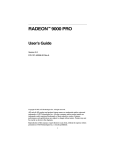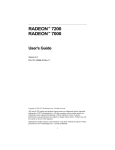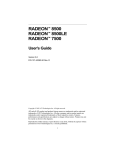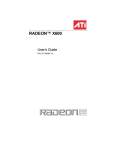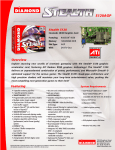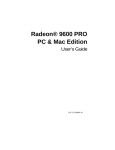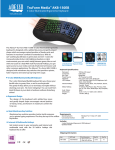Download 3D Connexion RADEON 9200 FSC Series 137-40465-10 User's Manual
Transcript
RADEON™ 9200 FSC Series User’s Guide P/N 137-40465-10 Copyright © 2003, ATI Technologies Inc. All rights reserved. ATI and all ATI product and product feature names are trademarks and/or registered trademarks of ATI Technologies Inc. All other company and/or product names are trademarks and/or registered trademarks of their respective owners. Features, performance and specifications are subject to change without notice. Product may not be exactly as shown in the diagrams. Reproduction of this manual, or parts thereof, in any form, without the express written permission of ATI Technologies Inc. is strictly prohibited. Disclaimer While every precaution has been taken in the preparation of this document, ATI Technologies Inc. assumes no liability with respect to the operation or use of ATI hardware, software or other products and documentation described herein, for any act or omission of ATI concerning such products or this documentation, for any interruption of service, loss or interruption of business, loss of anticipatory profits, or for punitive, incidental or consequential damages in connection with the furnishing, performance, or use of the ATI hardware, software, or other products and documentation provided herein. ATI Technologies Inc. reserves the right to make changes without further notice to a product or system described herein to improve reliability, function or design. With respect to ATI products which this document relates, ATI disclaims all express or implied warranties regarding such products, including but not limited to, the implied warranties of merchantability, fitness for a particular purpose, and non-infringement. Product Notice MACROVISION A.Apparatus Claims of U.S. Patent Nos. 4,631,603, 4,577,216, 4,819,098, and 4,907,093 licensed for limited viewing users only. B.In the printed collateral material that accompanies the Product, the following notice must be printed in an appropriate place in such materials: This product incorporates copyright protection technology that is protected by method claims of certain U.S. patents and other intellectual property rights owned by Macrovision Corporation and other rights owners. Use of this copyright protection technology must be authorized by Macrovision Corporation, and is intended for home and other limited viewing uses unless otherwise authorized by Macrovision Corporation. Reverse engineering or disassembly is prohibited. i Table of Contents Disclaimer ............................................................................................... i Product Notice......................................................................................... i MACROVISION..................................................................................... i Introduction. . . . . . . . . . . . . . . . . . . . . . . . . . . . . . . . . . 1 Features At A Glance .................................................................................. 2 RADEON 9200 FSC Series ................................................................... 2 ATI’s Catalyst™ Software Suite ................................................................ 3 Multiple Displays and 3D Gaming Experience...................................... 3 Direct 3D® and OpenGL® .................................................................... 3 HydraVision™ ....................................................................................... 4 Connecting Your Monitor . . . . . . . . . . . . . . . . . . . . . . 5 Display Configurations................................................................................ 6 Catalyst™ Software Suite . . . . . . . . . . . . . . . . . . . . . . 7 ATI Displays Tab......................................................................................... 7 Enabling/Disabling Secondary Displays (optional) ............................... 8 Enabling Extended Desktop Mode (optional) ........................................ 8 Dynamic Display Reassignment (optional)............................................ 8 Virtually Repositioning Your Displays (optional) ................................. 9 ATI Color Tab ........................................................................................... 10 ATI Options Tab........................................................................................ 12 ATI Overlay Tab ....................................................................................... 14 Video Overlay ...................................................................................... 14 Clone Mode Settings ............................................................................ 15 OpenGL® Control Panel . . . . . . . . . . . . . . . . . . . . . . 17 Main and Custom Settings........................................................................ 17 OpenGL® Compatibility Settings............................................................ 20 Direct 3D® Control Panel. . . . . . . . . . . . . . . . . . . . . . 22 Main and Custom Settings........................................................................ 22 Direct 3D® Compatibility Settings .......................................................... 25 Using TV Out. . . . . . . . . . . . . . . . . . . . . . . . . . . . . . . . 27 View your PC’s display on a TV.......................................................... 27 Connecting to a TV or a VCR .................................................................. 28 Starting Windows® with TV Display Enabled .................................... 30 Using SCART Connectors for European TVs ..................................... 30 How To Enable/Disable The TV Display ............................................ 31 ii Using and Adjusting TV Out................................................................ 31 How TV Display Cannot Be Used ....................................................... 31 Using a Monitor vs. Using the TV Display.......................................... 32 Adjusting Monitor Display................................................................... 32 Viewing Text on a TV.......................................................................... 33 Reducing Edge Distortion .................................................................... 33 Changing Display Configurations ........................................................ 35 Using Games and Applications ............................................................ 35 Connect to a TV, VCR, or Camcorder for video capturing .................................................................................... 37 Windows® Volume Control................................................................. 38 Capturing video using Windows® Movie Maker..................................................................... 40 iii 1 Introduction The RADEON™ 9200 FSC Series graphic accelerators delivers ground breaking 3D graphics performance. • Designed and built by ATI Technologies Inc. • Powered by the RADEON™ 9200 Series Graphics Processing Units (GPU). • Awesome 3D gaming performance. • Support for OpenGL® applications. • Support for Direct 3D® applications. • High resolution in 3D up to 2048x1536. • Best performance for today’s and tomorrow’s applications. • Supports TV-out to connect your PC to your TV or VCR. 2 Features At A Glance RADEON 9200 FSC Series The RADEON 9200 FSC Series provides high performance acceleration for today's demanding 3D graphic applications. Its main features are: • VIDEO IMMERSION™ II which provides industry-leading DVD playback and digital TV decode capability. • CHARISMA ENGINE™ II which is the main GPU, providing the necessary power to accelerate today’s 3D games and applications. • SMARTSHADER™ technology which can realistically create the visual properties of any material, like glass, metal, wood, and produce 3D depth by rendering the object’s shadows. • SMOOTHVISION™ which provides users with various degrees of jagged edge removal from 3D images, allowing users to configure their own high quality or high performance gaming experience. • PIXEL TAPESTRY™ II which provides even greater 3D rendering power. • Dual monitor support (optional). • TV output support. 3 ATI’s Catalyst™ Software Suite Multiple Displays and 3D Gaming Experience ATI’s Catalyst Software Suite provides multiple display functionality for those computers with support for more than one installed monitor, and the advanced graphic features, such as SMARTSHADER, for the ultimate 3D gaming experience. For help on installing the Catalyst™ Software Suite, refer to the Getting Started Guide. The Catalyst™ Software Suite installs the ATI display tabs. These tabs are accessed through the Windows® Display Control Panel, through the Advanced... button located on the Settings tab. For a detailed explanation of each ATI tab, refer to Catalyst™ Software Suite on page 7. Direct 3D® and OpenGL® The Catalyst Software Suite also supports the latest versions of Direct 3D® and OpenGL®. Many new 3D game titles, and the latest versions of older titles, will virtually come to life as they utilize their advanced Direct 3D® or OpenGL® features. Gamers can fine-tune their settings for the ultimate experience in 3D image quality or 3D gaming performance. ATI’s Direct 3D® and OpenGL® tabs are available through the Windows® Display Control Panel, through the Advanced... button located on the Settings tab. For a detailed explanation of the Direct 3D® and OpenGL® tabs, refer to Direct 3D® Control Panel on page 22, and OpenGL® Control Panel on page 17. 4 HydraVision™ (Optional) In addition to the multiple display functionality available with ATI’s Catalyst Software Suite for those computers with support for more than one installed monitor, you can also use HydraVision™ for advanced multi-monitor management. For more information on HydraVision, please refer to the HydraVision User’s Guide PDF located on your ATI Installation CD. 5 Connecting Your Monitor The RADEON 9200 FSC Series provides hardware support for one VGA monitor. It also provides TV Output via a S-Video out or a Composite out connector. Plug the monitor cable into your card then turn on the PC and monitor(s). S-Video Composite Composite S-Video VGA CONNECTOR FROM MONITOR STANDARD VGA MONITOR CONNECTOR Or S-Video STANDARD VGA MONITOR CONNECTOR VGA CONNECTOR FROM MONITOR 6 Display Configurations The following table lists the different ways you can connect displays to your card. Display Configuration Connector(s) Used Comments One CRT display VGA connector CRT- cathode ray tube analog display One TV TV Output Cards with S-Video out also support Composite out via a S-Video-to-Composite adapter*. Cards with Composite out DO NOT support connection to TVs with S-Video Input. CRT display + TV VGA connector + TV Output 7 Catalyst™ Software Suite The following section provides an explanation of each ATI tab available after installing the Catalyst Software Suite. i Features presented in the following pages may not be supported in all operating systems and/or may appear differently. ATI Displays Tab The ATI Displays tab provides the multi monitor features for those computers with support for more than one installed monitor. Here you can enable/disable display devices and swap the assignment of Primary and Secondary displays. 8 Enabling/Disabling Secondary Displays (optional) 1 Access the Windows® Control Panel. Doubleclick Display. 2 Click on the Settings tab and then the Advanced... button. 3 Click on the ATI Displays tab. 4 Click the enable/disable button for the display device you want to enable/disable. 5 Click OK or Apply to save the changes. Enabling Extended Desktop Mode (optional) 1 Access the Windows® Control Panel. Doubleclick Display. 2 Click on the Settings tab. 3 Click the monitor icon for the display onto which you want to extend your desktop. 4 Click Yes to enable the selected display. 5 Checkmark the Extend my Windows desktop onto this monitor check box (Windows® may automatically place it there). 6 Click OK or Apply to save the changes. Dynamic Display Reassignment (optional) You can change the assignment of your Primary and Secondary display on the fly, without rebooting. However, before you can change the assignment of the Primary display, at least one Secondary display must be enabled, and Extended Desktop mode must be enabled. To enable a Secondary display, refer to the section Enabling/Disabling Secondary Displays (optional). 9 To enable Extended Desktop Mode, refer to the section Enabling Extended Desktop Mode (optional). 1 Access the Windows® Control Panel. Doubleclick Display. 2 Click on the Settings tab and then the Advanced... button. 3 Click on the ATI Displays tab. The ATI Displays tab shows you the display(s) that are active. The Primary display has the button depressed. To change the display assignment, you can click the Primary display’s button or you can click the button of the other display device. 4 Click OK or Apply to save the changes. Virtually Repositioning Your Displays (optional) 1 On the Settings tab, click and drag the appropriate monitor icon to the desired position. For example, the secondary display can be dragged to the left of the primary display, allowing it to be virtually on the left, as shown below. 2 Click OK or Apply to save the changes. 10 ATI Color Tab The ATI Color tab is used to adjust the color settings. You can change the red, green and blue display colors. Desktop brightness and Game Gamma (brightness) can also be changed. ATI Color Tab Desktop Brightness This increases or decreases the brightness of your desktop. The higher the gamma value, the higher the brightness of your display. Color Curve This adjusts the selected color (red, green or blue check button) by moving the color curve with your mouse. Game Gamma button This accesses Game Gamma Properties. Defaults button This allows you to reset the desktop brightness and color settings to default values. 11 Clicking the Game Gamma button accesses the Game Gamma Properties. Game Gamma Properties Red Green Blue sliders These controls allow you to increase or decrease the color brightness of Direct 3D® and OpenGL® games played in fullscreen mode. RGB Lock Uncheck this to adjust the RGB sliders individually. Check this to adjust all three sliders at the same time. Defaults button This allows you to reset the Game Gamma settings to default values. 12 ATI Options Tab The ATI Options tab provides detailed driver information and access to the card’s specifications. You can also enable or disable the ATI taskbar icon. ATI Options Tab Version Information Provides the Catalyst version number, 2D version number and the driver build information. Details button Provides access to the Details tab which lists the card’s hardware details and driver information. Reactivate all warning messages This allows you to reactivate any disabled graphics warning messages. Enable ATI taskbar icon application Unchecking this allows you to disable the ATI taskbar applications and removes the ATI icon from your system tray. Show ATI icon on taskbar Unchecking this allows you to remove the ATI icon from your system tray without disabling the ATI icon applications. 13 Disable quick resolution feature Quick resolution feature is accessible by leftclicking the ATI icon in the system tray. Checking this option disables the feature. Reduce DVI frequency on highresolution (optional) Resolves display corruption or no image at high resolutions (for example 1280x1024 @75Hz) using a digital DVI display. (This setting has no effect when using a DVI-to-VGA adapter.) Alternate DVI operational mode (optional) Use this option if you are experiencing display corruption on your DVI flat panel. Clicking the Details button provides access to the Details tab. 14 ATI Overlay Tab The ATI Overlay tab allows you to configure the brightness, contrast, saturation, hue and gamma properties of your video overlay. Video Overlay Video overlay allows for the viewing of full-motion video on your PC. However, there is only one video overlay, which is only available on the Primary display. The video overlay controls are automatically activated during playback of any video file type that supports overlay adjustments. 15 ATI Overlay Tab Brightness Use this slider to adjust the brightness of the video image. Contrast Use this slider to adjust the contrast in the video image. Saturation Use this slider to adjust the vividness of the color. Sliding it all the way to the left removes all color and produces a black and white picture. Hue Use this slider to adjust the pureness or tint of the red, green and blue components of the color. Gamma Use this slider to adjust the overall intensity of the video image. Clone mode options (optional) Click this button to access Clone Mode overlay settings.These settings only apply to video content when viewed in dual-controller Clone mode. Defaults button This allows you to reset the Overlay settings to default values. Clone Mode Settings Clone Mode Options Standard Video content is displayed on your Primary display only. Theater Mode Video content is displayed on your Primary and Secondary displays. Video content is displayed on your Secondary display(s) is always in full screen mode. Note: your computer must be set for 16-bit color depth or higher to use this mode. Same on all Video content is displayed on your Primary and Secondary display is exactly the same manner. For example, all displays will show video output in full screen mode. Theater Mode Settings These settings are available when Theater Mode is selected. Same as source video The aspect ratio of the source video is maintained for full screen display. Note: that this option may result in black bars on either the horizontal or vertical sides of the video display. 16 Full Screen Video The source video is scaled so that your display is showing full screen. Note: if the source video contains horizontal black bars, as do some DVD movies, the full screen video will also contain black bars. 4:3 (Standard TV) Select this option if the aspect ratio of the display device showing full screen video has the standard 4:3 aspect ratio (standard TVs and monitors). 16:9 (Widescreen) Select this option if the aspect ratio of the display device is showing full screen video has a 16:9 aspect ratio (widescreen HDTVs). 17 OpenGL® Control Panel Using this tab, gamers can fine-tune the settings for OpenGL® games. Main and Custom Settings In the Main Settings you can maximize overall performance by moving the slider to the left, or you can enhance overall image quality by moving the slider to the right. 18 Main Settings slider This allows you to emphasize what kind of application experience you’d like to have. Moving the slider to the left will maximize application performance, while moving the slider to the right will provide excellent 3D image quality. Moving this slider from one position to the next changes the individual Custom Settings sliders found below. Custom Settings checkbox When Custom Settings is checked, the Main Settings slider is disabled, allowing you to move each individual slider in the Custom Settings section below. Setting the individual sliders gives you complete control over your application experience. Using Custom Settings is recommended for advanced users only. Anisotropic Filtering checkbox Anisotropic filtering uses a texture filtering technique that blends multiple texture samples together. Selecting Application Preference will result in high quality textures, with a negligible reduction in the application’s performance. Anisotropic Filtering slider The number of samples taken when anisotropic filtering is performed can vary. By moving this slider to the right, as the number of samples taken increases, the quality of the final image increases significantly. 16X provides extremely detailed, crisp-looking images as a result of the largest number of texture samples possible. SMOOTH VISION checkbox SmoothVision (Anti-Aliasing) improves image quality by removing jagged edges from 3D images, resulting in smoother, more natural-looking objects. Selecting Application Preference will result in high quality images, with a negligible reduction in the application’s performance. SMOOTH VISION Performance button Select Performance for the best possible 3D gaming performance at a slight reduction in 3D image quality. The maximum screen resolution possible will automatically be indicated. SMOOTH VISION Quality button Select Quality for the best possible 3D image quality at a slight reduction in 3D gaming performance. The maximum screen resolution possible will automatically be indicated. SMOOTH VISION slider SmoothVision (Anti-Aliasing) can be applied using different sample patterns and sample points such as 2X or 4X. Moving this slider to the right increases sampling to provide the most realistic 3D image. 19 Texture Preference slider Selecting this decides whether your application should use high quality or high performance textures. Moving the slider to the right delivers the highest quality experience. Moving the slider to the left emphasizes a high performance solution while still providing good visuals. Mipmap Detail Level slider This will allow you to choose the texture quality of the mipmaps the application will use. Mipmaps are a collection of different sized textures of the same image. As the user moves closer to a 3D object the image quality should increase, requiring a higher quality texture of the same image. The base mipmap is the highest quality texture, and all subsequent mipmaps are smaller sized textures of the same image. Moving the slider to the right selects a higher quality base mipmap, delivering the highest quality application experience. Moving the slider to the left selects a lower quality mipmap, delivering the highest application performance. Wait for Vertical Sync Wait for vertical sync will lower the frame rate of full screen games but reduce the image tearing that can occur with the higher frame rate. Selecting Application Preference allows the application to decide whether or not it should display its frames at the refresh rate of the monitor. Selecting Always Off allows the application to run at its highest possible frame rate, regardless of the monitor’s refresh rate which is typically less than the frame rate at which the application will run. TRUFORM Truform uses High Order Surface geometry to generate more detailed and realistic terrain and character models for applications that support this technology. Select Application Preference to enable Truform. Select Always Off to disable Truform. Compatibility Settings button This button allows you to access advanced settings that can solve compatibility issues for a few specific OpenGL® applications. Defaults This button allows you to reset the OpenGL® settings to default values. 20 OpenGL® Compatibility Settings Force Z-buffer depth This allows you to explicitly set the Z-Buffer depth. Most applications will work best when Disabled is selected Alpha dithering method When applications use both dithering and alpha blending, visual artifacts can occur. This option allows you to select how the application should handle both features at the same time. In most cases Error Diffusion will handle this situation quite well, but there are a few cases where selecting Ordered may be necessary Support KTX buffer region extension Enabling this feature allows rapid updates of those portions of your screen that have changed. Note that most applications will not be affected by activating this feature Defaults button This button allows you to reset the OpenGL® Compatibility Settings to default values. 21 22 Direct 3D® Control Panel Using this tab, gamers can fine-tune the settings for Direct 3D® games. Main and Custom Settings In the Main Settings you can maximize overall performance by moving the slider to the left, or you can enhance overall image quality by moving the slider to the right. 23 Main Settings slider This allows you to emphasize what kind of application experience you’d like to have. Moving the slider to the left will maximize application performance, while moving the slider to the right will provide excellent 3D image quality. Moving this slider from one position to the next changes the individual Custom Settings sliders found below. Custom Settings checkbox When Custom Settings is checked, the Main Settings slider is disabled, allowing you to move each individual slider in the Custom Settings section below. Setting the individual sliders gives you complete control over your application experience. Using Custom Settings is recommended for advanced users only. Anisotropic Filtering checkbox Anisotropic filtering uses a texture filtering technique that blends multiple texture samples together. Selecting Application Preference will result in high quality textures, with a negligible reduction in the application’s performance. Anisotropic Filtering slider The number of samples taken when anisotropic filtering is performed can vary. By moving this slider to the right, as the number of samples taken increases, the quality of the final image increases significantly. 16X provides extremely detailed, crisp-looking images as a result of the largest number of texture samples possible. SMOOTH VISION checkbox SmoothVision (Anti-Aliasing) improves image quality by removing jagged edges from 3D images, resulting in smoother, more natural-looking objects. Selecting Application Preference will result in high quality images, with a negligible reduction in the application’s performance. SMOOTH VISION Performance button Select Performance for the best possible 3D gaming performance at a slight reduction in 3D image quality. The maximum screen resolution possible will automatically be indicated. SMOOTH VISION Quality button Select Quality for the best possible 3D image quality at a slight reduction in 3D gaming performance. The maximum screen resolution possible will automatically be indicated. SMOOTH VISION slider SmoothVision (Anti-Aliasing) can be applied using different sample patterns and sample points such as 2X or 4X. Moving this slider to the right increases sampling to provide the most realistic 3D image. 24 Texture Preference slider Selecting this decides whether your application should use high quality or high performance textures. Moving the slider to the right delivers the highest quality experience. Moving the slider to the left emphasizes a high performance solution while still providing good visuals. Mipmap Detail Level slider This will allow you to choose the texture quality of the mipmaps the application will use. Mipmaps are a collection of different sized textures of the same image. As the user moves closer to a 3D object the image quality should increase, requiring a higher quality texture of the same image. The base mipmap is the highest quality texture, and all subsequent mipmaps are smaller sized textures of the same image. Moving the slider to the right selects a higher quality base mipmap, delivering the highest quality application experience. Moving the slider to the left selects a lower quality mipmap, delivering the highest application performance. Wait for Vertical Sync Wait for vertical sync will lower the frame rate of full screen games but reduce the image tearing that can occur with the higher frame rate. Selecting Application Preference allows the application to decide whether or not it should display its frames at the refresh rate of the monitor. Selecting Always Off allows the application to run at its highest possible frame rate, regardless of the monitor’s refresh rate which is typically less than the frame rate at which the application will run. TRUFORM Truform uses High Order Surface geometry to generate more detailed and realistic terrain and character models for applications that support this technology. Select Application Preference to enable Truform. Select Always Off to disable Truform. Compatibility Settings button This button allows you to access advanced settings that can solve compatibility issues for a few specific Direct 3D® applications. Defaults This button allows you to reset the Direct 3D® settings to default values. 25 Direct 3D® Compatibility Settings Support Wbuffer This will enable W-Buffer support for 3D games. It is recommended to disable this for games that do not support this feature. Certain applications require the increased precision of W-Buffering and will exhibit artifacts unless the W-Buffer is enabled. Support 32-bit Z-buffer depth Z-Buffer Bit Depth can be 16 bits, 24 bits, or 32 bits. 16 and 24 are selected by default to achieve optimum performance. Very few applications require a 32 bit ZBuffer, so in most cases this feature should be disabled. Alpha dithering method When applications use both dithering and alpha blending, visual artifacts can occur. This option allows you to select how the application should handle both features at the same time. In most cases Error Diffusion will handle this situation quite well, but there are a few cases where selecting Ordered may be necessary. 26 Support DXT texture formats Enabling this allows applications to use this kind of texture format. There are a few applications that can only support a limited number of texture formats. By selecting Disabled, the driver will not support DXT texture formats, thus reducing the number of texture formats supported. Alternate pixel center This may eliminate problems with some D3D games which display vertical and horizontal lines around textures, or text that appears incorrect. However, this setting should only be used if you are experiencing the symptoms mentioned, as it may cause problems with other games. Defaults button This button allows you to reset the Direct 3D® Compatibility Settings to default values. 27 Using TV Out View your PC’s display on a TV The RADEON 9200 FSC Series has TV Out capability. You can attach your card to a TV and monitor at the same time. Or you can connect it to your VCR and record your monitor’s display. TV display is ideal for playing games, giving presentations, watching movies, and browsing the Internet. The following tips will help you get the most out of your TV Out feature. IMPORTANT INFORMATION for European Customers Some PC monitors in Europe cannot be used simultaneously with TV display. When you enable TV display in Europe, the refresh rate for the monitor and TV is set to 50Hz. Some monitors may not support this refresh rate and could be damaged. • Please check the documentation supplied with your monitor to see if your monitor supports a refresh rate of 50Hz. If your monitor does not support 50 Hz (or if you are not sure), then turn off your monitor before turning on your PC when using your TV as a display. For information on disabling TV display, see How To Enable/Disable The TV Display on page 31. Some TVs in Europe may use a SCART connection. If you use SCART, please read Using SCART Connectors for European TVs on page 30 before attempting to connect your PC to your European TV. 28 Connecting to a TV or a VCR To connect your card to a TV or a VCR, use the available TV Output connector. Your card will support either a S-video connector or a Composite connector. If your TV has cable input only, you can connect your card to your TV through your VCR or an RF modulator (available in most electronics stores). The RADEON 9200 FSC Series with only a Composite out connector DOES NOT support connection to TVs with S-Video In. Connecting Your TV Output to a TV or VCR 1 Turn off your PC and your TV (or VCR). 2 Determine if your TV (or VCR) has a S-Video In or Composite In connection. 3 The TV Output on your card will be a S-Video connector or Composite connector. If your system shipped with a 4-to1 adapter cable, connect this cable and an additional S-Video or Composite cable as shown. Otherwise connect a S-Video or Composite cable only to the TV Output on your video card. Attach the other end of the cable to your TV (or VCR). 4 Turn on your PC and your TV (or VCR). 29 RADEON 9200 FSC Series S-Video Cable or Composite Cable OR RADEON 9200 FSC Series S-Video Cable OR RADEON 9200 FSC Series S-Video-to-composite Adapter Cable Composite Cable 30 Starting Windows® with TV Display Enabled The TV screen may become scrambled during the initial Windows® logo display. This is only a temporary effect and your screen will be restored within a few seconds. During start up, your card will go through a sequence of mode settings, during which your TV display will remain blank. This process takes only a few seconds and helps program the TV display. Using SCART Connectors for European TVs Audio In (Right = red) (Left = white) Connect to TV or VCR Audio Cable Connect to PC Audio Out Composite Cable or SCART CONNECTOR S-Video-to-Composite Adapter Cable Connect to PC TV Output Composite Video-In (yellow) OR Audio In Connect to TV or VCR (Right = red) (Left = white) Audio Cable Connect to PC Audio Out Composite Cable or SCART CONNECTOR S-Video-to-Composite Adapter Cable Composite Video-In (yellow) Connect to PC TV Output The above illustration shows how to connect your PC to a European TV using the SCART. 31 The SCART connector supports only the Composite video format, which means you will have to use a S-Video-to-Composite video adapter cable if your card only supports the S-Video connector. If your European TV has S-Video In, you can use a S-Video cable (available in most consumer electronic stores) rather than the SCART connector if your card only supports the S-Video connector. A RADEON 9200 FSC Series with only a Composite out connector DOES NOT support connection to TVs with S-Video In. How To Enable/Disable The TV Display 1 Access the Windows® Control Panel. Doubleclick Display. 2 Click on the Settings tab and then the Advanced... button. 3 Click on the ATI Displays tab. Click on the TV button. 4 Click the enable/disable button. 5 Click OK or Apply to save the changes. Using and Adjusting TV Out For information about how to use TV display, right click the ATI taskbar icon, point to Help, then point to ATI Television Display. How TV Display Cannot Be Used A TV cannot be left connected to the card if two analog monitors are connected, even if the TV is off and not enabled in the software. 32 Using a Monitor vs. Using the TV Display Using your TV for your PC’s display is ideal for playing games, giving presentations, watching movies, and browsing the Internet. However, the display on your monitor may change or looked squashed. This occurs because the display adjusts to fit the dimensions of your TV. To correct the monitor’s display, use the monitor’s control buttons to adjust its display size and position. Some single frequency monitors may not work with TV display enabled. If you experience problems when TV display is enabled, disable TV display to restore your monitor’s display. Adjusting Monitor Display The size of the display on your monitor may be smaller and not perfectly centered when you have TV display enabled. These effects are caused by the changes required to provide a proper display on the TV. Use the controls available on the Adjustments tab on the Monitor Properties page (accessible by clicking on the Monitor button on the ATI Displays tab) to adjust the display on your monitor only. Click on the TV button to adjust the TV display only. 33 Viewing Text on a TV A TV is designed primarily to show moving, rather than static, images. The large dot pitch of a TV (which is fine for moving video) will yield poor quality static images such as text. The small text sizes commonly used for PC desktops can appear blurred or unclear on a TV. You can compensate for this by using larger fonts. To Use Larger Display Fonts 1 Access the Windows® Control Panel. Double- click Display. 2 Click the Settings tab, the Advanced... button, then the General tab. 3 In the Font Size box, select the size you want your displayed fonts to be. 4 Click Apply. If prompted, click Yes to restart your PC. Reducing Edge Distortion When using a TV for your PC’s display, you may see some edge distortion on the left and right side of your TV screen. This effect depends on your TV and the PC application you are running. To reduce edge distortion, you can increase the TV display’s horizontal size. To Increase the Horizontal Size 1 Access the Windows® Control Panel. Double- click Display. 2 Click on the Settings tab and then the Advanced... button. 3 Click on the ATI Displays tab. 34 4 Click on the TV button. 5 Click the Adjustments tab. 6 In the Screen Size section, click on the plus (+) button beside the horizontal arrowheads to increase the horizontal size of the TV display. 7 Click OK or Apply to save the changes you have made. You can also reduce edge distortion by increasing the TV’s contrast. To Increase the TV Contrast 1 Access the Windows® Control Panel. Double- click Display. 2 Click on the Settings tab and then the Advanced... button. 3 Click on the ATI Displays tab. 4 Click on the TV button. 5 Drag the Contrast slider to the right to increase the contrast. 6 Click OK or Apply to save the changes you have made. 35 Changing Display Configurations If you move your PC to a place where you are using TV display only, make sure that you have the TV display feature enabled. You can set your display resolution as high as 1024x768. However, higher resolutions will result in a virtual desktop. If a TV is your only display device and a higher mode is selected, the display on your TV will disappear. Using Games and Applications Some older games and applications may program the card directly, to run under a specific display mode. This may cause your TV display to turn off automatically or become scrambled (the PC monitor will not be affected). Your TV display will be restored once you exit the game or if you restart your PC. 36 37 Connect to a TV, VCR, or Camcorder for video capturing Some versions of the RADEON 9200 FSC Series have video capturing capabilities from your camcorder, VCR, or TV. Use your favorite video editing application to add effects, make edits, or stream your video on the internet. Connect a TV, camcorder, or VCR to your RADEON 9200 FSC Series graphics card, as shown. RADEON 9200 FSC Series S-Video Cable or Composite Cable Or 38 RADEON 9200 FSC Series S-Video Cable or Composite Cable Windows® Volume Control For correct audio performance, your sound card’s line input must be active. To display the Line Input setting in the Windows® Volume Control panel: 1 Right-click the speaker icon in the Taskbar (usually in the lower-right corner of your screen). 2 Click Open Volume Controls. 3 If the Line-In volume slider is not visible, click Options, then click Properties. 39 4 Click the Line-In volume control checkbox, then click OK. If the Mute checkbox is checked, click it to cancel muting. If the volume icon is not in your Taskbar, do the following: • Click Start, then click Control Panel. • Double-click Sounds and Audio Devices. • In the Volume tab, check Place volume icon in the taskbar. 40 Capturing video using Windows® Movie Maker To capture video with Windows® Movie Maker: 1 Click Start then All Programs then Accessories then Windows® Movie Maker. 2 Click the Record button to open the Record dialog. 3 Select Record both to record video and audio. 4 Choose record quality. a Click Change device... b Click Configure... c Locate the Video Standard selection box. d Choose the video standard appropriate for your country (PAL for most of Europe, NTSC for North America). 5 Start playback from your camcorder or VCR. 6 Click Record button. For detailed information on using Windows® Movie Maker see the application’s Help files. 41














































